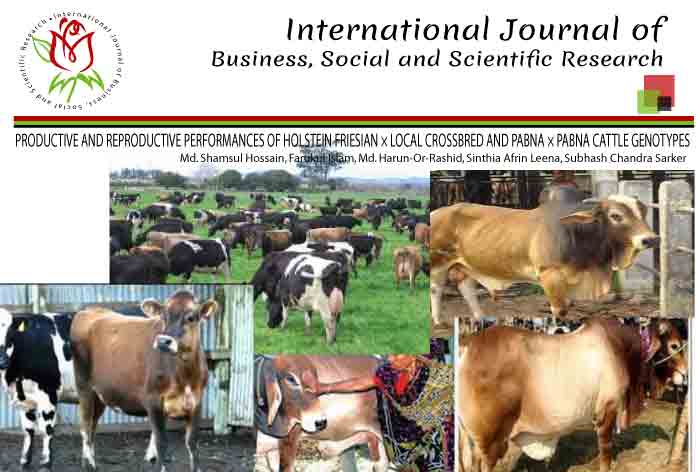PRODUCTIVE AND REPRODUCTIVE PERFORMANCES OF HOLSTEIN FRIESIAN × LOCAL CROSSBRED AND PABNA × PABNA CATTLE GENOTYPES

A total of 42 dairy cattle farmers from 20 villages of Vangura and Chatmohor upazilas of Pabna district and Singra, Gurudashpur and Boroigram upazilas of Natore district in Bangladesh during July 2015 to October 2015 were enumerated. Data on body measurements, milk production capacity, feeds and feeding and insemination system from two cattle genotypes like Holstein Friesian x Local crossbred (Crossbred) and Pabna x Pabna cattle (local) were used in this study. Higher body weight (323.95±0.72 kg), body circumference (165.89±0.72 cm) and body length (125.31±0.72 cm) were recorded for crossbred cows. Daily milk yield and lactation period were higher in crossbred (15.90±0.72 liter/cow; 9.67±0.72 months) than local (5.73±1.21 liter/cow; 8.42±1.21months) cattle. Farmers stopped milking earlier in local cows then the crossbred cows (42.87±0.72 days). Peak milk production in a whole lactation period was documented for both crossbred (80.95%) and local cows (86.67%) were the second month of the lactation period. However most of the farmers did not allocate milk for their calves with measurements. Farmers under this study fed rice straw, cut and carry green grass and a conventionally mixed concentrate mixture and concentrate mixtures composed with rice bran, maize bran, wheat bran, oil cake and broken pulses, common salt, etc. Crossbred cows took higher amount of grass (19.24±0.72 kg/day/cow) and concentrate (7.14±0.72 kg/day/cow) feed than local cow but local cow received higher amount of rice straw (7.53±1.21 kg/day/cow) than crossbred cow. Majority of the farmers used PRAN Dairy Ltd (47.62%) and BRAC (26.19%) supplied semen to inseminate their she cows but a few numbers of Pabna cows were mated with Pabna bull naturally (20.00%). Farmers in the study site were enough familiar with breeding technology and artificial insemination system were practiced highly.

